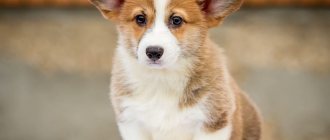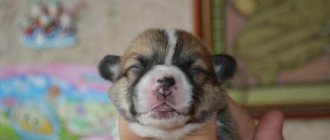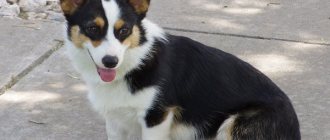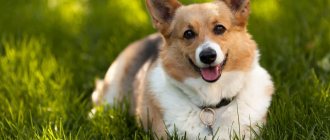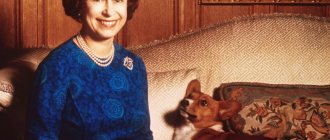Description of the Pembroke Welsh Corgi breed
Popularity 18th among 263 dog breeds
Lifespan:
10-12 years
Breed group:
Shepherd's
Height:
25-30 cm
Country of origin:
Great Britain
Average price:
25-30 thousand rubles
Weight:
9-13 kg
Latest articles Cat health
Rabies vaccination for cats: choice of vaccine, necessity, schedule 01/22/2022 20 0 0
Selection and adaptation
TOP 20 best cat breeds for families with children 01/22/2022 33 0 0
Socialization
If not only dogs live in the house, but also cats, birds, and hamsters, the corgi will be an excellent addition to the “menagerie.” He finds a common language with everyone, and can even make friends with iguanas and turtles.
Pembrokes are gentle and careful with children. They steadfastly endure all the pranks and involve the kids in their pranks. At the same time, corgis are strong enough to withstand kicks and pinches. And they are ready to run around and play with school-aged children from morning to evening.
Pembroke Welsh Corgis are cool towards strangers. But family friends are treated warmly, perceiving them as members of the pack coming and going.
Advantages and disadvantages
- Pros:
- high intelligence and quick learner;
- unpretentious in care;
- playful and friendly, sociable;
- gets along well with children;
- comfortable to keep in an apartment;
- there is no unpleasant odor.
- Minuses:
- difficulties in breeding;
- heavy shedding;
- chews things;
- bites legs during play;
- prone to hereditary joint diseases;
- high price.
They have a long herding history
Corgis have a long, long history as herding dogs. In fact, they were used as shepherds as early as the 10th century.
But why corgi? Their small stature gave them a huge advantage in cattle breeding. Their short stature not only gave them easy access to the shins and ankles of cows—they would bite the cattle to guide them in the right direction—but it also protected them from retaliatory strikes from the cows. Corgis are also known to be incredibly athletic and fast dogs.
Key facts
The Pembroke Welsh Corgi is an ideal pet and family friend. He adores children, it’s not scary to leave even a baby with him, the dog will forgive them anything. Corgis are perfect for those people who have never had a dog.
The characteristics of the Pembroke Welsh Corgi breed say that these dogs are very social. They love to be the center of attention and do not deny themselves the pleasure of once again cheering up their owner. At the same time, the Pembroke is friends with all family members, without becoming attached to one owner.
The Corgi will always try to stay close to the person, follow the heels, no matter what the owner does. If he wants attention, he will ask for it by gently poking him with his nose. If there is no answer, Pembroke will treat this with understanding and will not bother you anymore. Rather, he will lie down at your feet so as not to miss the moment when the owner is free.
The description of the Pembroke Welsh Corgi breed is replete with positive reviews. This breed is very kind and tolerant of children, they enjoy spending time in their company. They can act as a nanny, protecting the baby from danger and looking after him. No matter how much they are squeezed, they will never show their teeth to the child, but will humbly endure any games.
The Corgi has a keen mind and well-developed intuition, and also quickly and easily adapts to any environment.
The dog understands the owner’s mood well and will not impose his company at the wrong time. She is not touchy or vindictive.
Corgis are very optimistic and have a great sense of humor. If a dog sees that the owner reacts cheerfully to any action, he will definitely repeat it.
Like any herding dog, Welsh Corgis are obedient, not aggressive, but will only obey the commands of an owner who shows sensitivity, love and understanding towards them.
Pembroke Corgis are not very demanding to care for. Their coat is tough and water-repellent, so it does not require frequent washing. Due to their short stature, when walking in damp weather they can get their belly dirty. You can wash it separately with a special shampoo after a walk or get a jumpsuit.
Corgis shed a lot. It is advisable to brush at least once a week, and during the period of active shedding - every day, and also use the services of a groomer.
Pembrokes are prone to obesity, so it is necessary to control your pet’s food intake and prevent him from overeating. In the future, a sedentary lifestyle will negatively affect the spine, joints, as well as the well-being and life expectancy of the Pembroke Welsh Corgi.
The Pembroke Welsh Corgi breed has difficulties with breeding; in 80% of cases, births occur by caesarean section, so if you decide to become a breeder, you should approach this issue carefully and consult with a specialist.
Pembrokes and Cardigans are two separate breeds. They differ both in appearance and in character and temperament. The Cardigan is a more serious dog, while the Pembroke is not averse to fooling around.
Nowadays Pembroke corgis are at the peak of popularity. Their smiling faces collect a huge number of likes on social networks. Be prepared for increased attention on the street and questions like “did she have her legs docked too?”
Diseases of the breed
Both Cardigans and Pembrokes suffer from:
- Cystinuria is a hereditary kidney disease accompanied by the release of the amino acid cystine into the urine. In healthy animals, cystine is reabsorbed in the kidneys without entering the urine;
- persistent pupillary membrane - a defect in which the membrane that forms the iris is not formed correctly;
- progressive retinal atrophy;
- retinal dysplasia, it is formed incorrectly in this disease;
- lens displacement, it is in the wrong position.
Diseases affecting only cardigans:
- Combined immunological deficiency.
- Turning of the eyelid inward.
- Glaucoma is increased eye pressure.
- Lack of immunoglobulin G.
- Intervertebral disc disease.
Let's add to all of the above that bitches of both breeds often have problems with natural childbirth.
History of the origin of the Pembroke Welsh Corgi
The origin of this breed originates in Wales, which explains its name - “Welsh”. But the meaning of the word “corgi” is only surrounded by guesswork. It is believed that the name comes from the Welsh “cor” - “gather”, “gi” - “dog”, which is inherent in its herding instinct. According to another version, it comes from the word “cor”, which means “dwarf”, which also fits the description of this short-legged dog.
There are opinions that the origin of the breed dates back to 500 BC. e. Archaeologists discovered a corgi-like skeleton dating back to the 8th-9th centuries AD during excavations in South Wales.
There is a version that in the 9th century, corgis were brought to England by the Vikings.
The Pembroke Welsh Corgi breed was first mentioned in the laws of the kingdom dating back to the 10th century. According to the law, the owner of a corgi herding cattle had the right to demand a whole bull if the dog suddenly died a non-natural death. No other dog breed had the same value. Even if it belonged to the king, no one was worth more than one ram. This was explained by the fact that corgis were able to graze livestock on their own, without human accompaniment. They bravely defended the herds from wolves, returned stray livestock without loss, working as a well-coordinated team with their brothers.
These dogs looked after not only sheep, but also herds of ponies and poultry such as wayward ducks and geese. Corgis fully performed the function of a shepherd, which is why they were worth their weight in gold.
Corgis first began exhibiting in England in 1924. At that time, Pembrokes and Cardigans were considered the same breed, but with all the similarities and differences, it was very difficult to evaluate them at exhibitions. These dogs, different in size and body structure, were clearly not competitors to each other. Therefore, a year later, the decision was made to officially separate the two breeds and breed them separately from each other in two different counties in Wales. Two neighboring counties separated by a mountain range - Pembrokeshire and Cardinganshire - eventually became home to two different dogs: the Pembroke Welsh Corgi and the Cardigan Welsh Corgi.
Their popularity overtook them after their appearance at Buckingham Palace. In 1932, the Duke of York gave a Pembroke corgi puppy to his daughter, Elizabeth II. To this day, representatives of this breed do not leave the palace, actively participate in official receptions and are rightfully called royal dogs. It’s not for nothing that Her Majesty Queen Elizabeth II is the world’s most famous corgi connoisseur and connoisseur.
Corgi possibly translates to "dwarf dog"
There is some debate about the meaning of the word "Corgi", but there are two main theories:
- The Welsh word "cor" means "gather" and "gi" translates to "dog". Makes a lot of sense for a breed known for its champion herding skills, right?
- On the other hand, the word "kor" translates to "dwarf" in Welsh - and, again, "gi" translates to "dog".
The actual translation really depends on the Welsh woman or woman you speak to and their understanding of the word "kor". But given their experience as herding dogs and working dogs for fairies and elves, we think both translations are correct!
Appearance of the Welsh Corgi Pembroke
General impression
In the photo, the Pembroke Welsh Corgi is a small dog with a long body and short, strong legs. This is how it really is.
Head
The corgi's muzzle is similar to a fox's: the skull is wide and long, and has a narrowed nose. The eyes are round and always dark in color. The ears are erect, rounded, and small.
Neck
Medium length, smoothly passing from the withers to the skull.
Torso
Elongated, with a flat top.
Forelegs
The paws are short, straight, powerful, the bones are wide and strong. The elbows fit tightly to the chest.
Hind limbs
The paws are short, thinner than the front ones, but strong.
Tail
Natural – long, should not fall over the back. Often the tail is docked. There is a bobtail (naturally short ponytail).
Wool
Straight, hard, medium length with a dense short undercoat.
Color
Pembroke Welsh Corgi colors: golden red, light red, fawn, tri-color red with black back and white chest. There are no white individuals.
Size
Average height of the Pembroke Welsh Corgi: 25-30 cm at the withers. The optimal weight of a male is 12-13 kg, the weight of a female is 11-12 kg. In general, the weight of the Pembroke Welsh Corgi allows it to be carried in your arms, which can be extremely comfortable.
The size of the Pembroke Welsh Corgi is also good: they allow you to keep a dog even in studio apartments.
Description
Photo of the Welsh Corgi
The Welsh Corgi is a loyal, affectionate and intelligent dog. Despite the fact that the pet is small, it can have a stubborn and slightly impudent character. Therefore, firm and consistent training and socialization from an early age is necessary.
— Advertising —
The dog's features show a bit of a terrier: it is reminiscent of an elongated body. There are two varieties of Welsh Corgis: the Cardigan and the Pembroke. In general, the dogs are similar to each other, but they can still be distinguished. Both species require a moderate amount of exercise. They may be prone to becoming overweight, so it is important for dogs to be active.
Personality of the Welsh Corgi Pembroke
Ask any Pembroke owner and everyone will tell you that they are an intelligent, friendly and cheerful breed. The main merit of the remarkable character of the Pembroke Welsh Corgi is the fact that the dog is a herding dog, and this activity developed his intelligence and raised him to be a team player.
Pembrokes are active, mobile, love to play and frolic, and mischief. They give the impression of being a cheerful dog with their famous smile and cheerful personality.
Being shepherds, corgis were excellent at protecting their herds from wolves. Today's pet has inherited the fearlessness of its ancestors; it will not be afraid to fight a much larger opponent.
They also passed on the instinctive need to “organize the herd.” Pembroke needs everyone around him to walk as a group in the same direction. For these purposes, a four-legged pet can bite people's legs with its front teeth, as it would do when guiding a flock of sheep or geese. As a puppy, it can run after the legs of random passers-by while walking.
Corgis are food lovers. They are real gluttons, which is also an echo of an energy-consuming activity. But leading an apartment lifestyle and not refusing to indulge in something extra, they run the risk of overeating, which can lead to obesity and in the long term affect the pet’s health.
Of course, having a set of common characteristics, each Pembroke is individual as a person. You will never meet two absolutely identical dogs. One will be calm, the other will be more active, the third will be noisy. But in any case, this dog will always be the smartest, kindest and most loyal friend.
Dookie is the little princess's first pet
Little Lilibet already dreamed of her own pet at the age of 7. Young Elizabeth first saw cute, cheerful dogs in the house of friends of the Dukes of York - the Marquises of Bath.
Friendly, playful, fluffy corgi puppies with a “smiling” mouth immediately charmed the little girl. There were other dogs in the Duke family. But the girl, having fallen in love with the corgi at first sight, was simply “sick” with the idea of having her own pet.
The parents supported their daughter's wish. Moreover, the breed chosen by the girl belonged to good-natured, non-aggressive dogs that loved children. The Dukes of York went to Thelma Gray's nursery.
The little puppy was the offspring of a purebred Pembroke. Among his brothers, he stood out with his short tail. This is what played a decisive role in the fate of the future four-legged royal favorite. “You need to take a puppy that has something to wag. Otherwise, how will we understand whether he is happy or not?” – the Duke of York explained his choice.
So in 1933, the first corgi, a dog named Dookie, settled into the royal family. Initially, the puppy’s name was more noble - Rosavel Golden Eagle. But the Yorks decided to give him the nickname Duke - Duke. Over time, the dog's name was changed to Dookie for convenience.
Lilibet and her sister Margaret practically never parted with their new friend. Dookie ate from the hands of the little princesses, slept next to them on his own bed and, accompanying the girls everywhere, never let them get bored. The dog often appeared on the pages of newspapers - Dookie looked very funny next to his little mistress.
Soon the Dukes took a corgi girl, Jane, into their home. The purebred dog was also loved by the princesses. But their friendship with Dookie did not work out. Jane was matched with another dog. This is how the royal corgi dogs appeared. They were the boy Crackers and the girl Carol. However, the second died early, and Crackers lived happily until 1953 with the Queen Mother.
In 1939, Duki passed away. Jane lived with the girls at Windsor Castle during wartime. But in 1944, she was hit by a car and died. The girls, who had already lost two of their favorites, took this event very hard.
Education and training
Many will be surprised, but the same training methods are applied to the Welsh Corgi as to the Shepherd. Dog experts say that the psychological portraits of these two different breeds are very similar.
Therefore, from a very early age, this dog needs to be shown who is boss in the house: you need to be moderately strict and persistent with it. The main thing in raising and training a corgi is consistency of actions and due categoricalness. What was once prohibited should not be allowed later.
Corgis are highly trainable. No special techniques are required for it. They often take prizes in agility competitions and even perform in circuses.
The only thing that must always be maintained is the dog’s interest in training. If you repeat the same thing, the corgi will quickly get bored with it, and he will stop following commands. It is better to use a game format, changing the sequence of tasks and giving commands in a cheerful tone.
Before you bring your corgi puppy home, you should take care of the following:
- While your puppy is teething, hide all wires and shoes out of your baby's sight. Every time you see your puppy chewing on things, immediately stop this action with the command “ugh!” and give him a special toy in his teeth.
- For the first time, remove all carpets and place baby diapers in different rooms.
- After all the vaccinations, if possible, take your baby out for walks as often as possible so that he gradually gets used to going to the toilet outside. The first walks can be 10-15 minutes 4-5 times a day, then the walking time can be increased and the number reduced.
When teaching a puppy commands, first of all you need to teach him to respond to his nickname. Say your pet's name every time you speak to him.
The first command learned after the name is “come to me!” You should definitely say the dog’s name when calling it to you.
The "place" command is also pronounced along with the dog's name. Next, the puppy must be moved to a specially designated place or bed.
Pembrokes easily master the “bring it!” command. Hold your baby by the collar while you throw the ball or stick, then release him after giving the command. Don't forget to praise your pet and reward him with a treat for his performance.
Thanks to their ability to learn quickly, corgis do not need professional work with dog handlers. They easily learn everything at home, and then delight the whole family with their talents.
Looking for a Pembroke Welsh Corgi? Find your pet from 3 offers Buy as a gift
Character traits
Dogs of this breed are very cheerful and see everyone as their friend, be it another pet or a stranger. It is extremely rare to see them show groundless aggression towards someone. But if the owner is in danger, according to the corgi, they will immediately come to the defense.
These pets are obedient and devoted, and most importantly, they will definitely not let their owner get bored. They have excellent memory, are curious, and thanks to these qualities they are very trainable.
NOTE!
When training is carried out in a playful way, the dwarf Welsh Corgi will grasp everything on the fly. Also, you should not raise your voice at the dog, as the corgi may perceive this as aggression. Most of all, these pets like it when their owner laughs; for them this is a real reward.
Health and disease of the Pembroke Welsh Corgi
Possible diseases
Thanks to the same herding activity, the Welsh Corgi is distinguished by fairly good health and endurance. If you get all your vaccinations on time, don’t overfeed, and see a veterinarian from time to time, then there shouldn’t be any health problems. True, there are some risk factors:
- There are diseases of the ears and eyes. They are advised to regularly visit an ophthalmologist veterinarian as a preventive measure.
- Pembroke puppies can suffer from a very unusual disease called narcolepsy. This means that while they are actively awake, they may suddenly fall asleep. In this case, do not wake your pet. With age, he will outgrow this disease.
- Problems with the spine due to short legs and long body. This breed is not allowed to jump, as they may get injured. Until the puppy has grown up and become stronger, it is necessary to carry him in your arms down stairs and not let him jump from high curbs.
- Obesity. Monitor your pet's diet and activity. They are still gluttons.
- The problem with the joints also affected them, like other short-legged animals. The disease is hereditary, so they should be monitored from childhood.
To avoid problems in the future, buy a puppy from trusted breeders and ask for a certificate of health from its parents.
Reproductive health
Expect the bitch to have her first heat at six months - yes, this is quite early, but it will not last long, about 10 days of bleeding. It is not worth mating during the first heat: pregnancy may not occur, or may occur with complications, miscarriages and other troubles.
During childbirth, be close to your dog, calm him down, but it is better not to pick up newborn puppies. The dog itself will allow this a little later, in a couple of days.
Corgis are dogs from Welsh legends.
According to Welsh legends, Pembroke Corgis were workhorses for fairies and elves who lived throughout Wales. They not only pulled fairy carts, but also helped herd fairy cattle and carried fairy warriors into battle. Need proof? Some say - if you look closely - you can still see fairy saddle marks on the shoulders in the Pembroke Corgi's coat.
Features of feeding and diet
Pembrokes are unpretentious eaters. They are ready to eat anything, which is not always good. Experts recommend feeding your dog premium food, which contains all the necessary substances. But feeding with natural products is also allowed, the main thing is to provide a balanced diet.
In the second case, the diet should contain proteins (meat, boiled eggs, low-fat cottage cheese) and carbohydrates (buckwheat porridge, rice), as well as fiber in the form of vegetables. Fruits are allowed in small quantities.
Pork, fresh meat, bones, lamb, as well as milk, potatoes, legumes and citrus fruits are undesirable.
Puppies are fed small meals 5 times a day. As you get older, the number of meals is reduced and the serving size is increased. The water should be changed regularly, 2-3 times a day.
Care and maintenance
Corgis have virtually no characteristic dog odor, so there is no need to bathe them often. True, due to short legs, the abdomen can get dirty in wet weather. It is recommended to wash your dog with specialized products, thoroughly rinsing off any residue from the fur.
It is necessary to examine and clean the ears as needed, and trim the nails once every 1-2 weeks. This breed is prone to eye diseases, so you need to examine them daily, wipe them and remove dirt.
Welsh Corgis shed twice a year. During this period, it is necessary to comb your pet daily.
Pembroke will feel comfortable both in an apartment and in a country house. It is unacceptable to keep him on a leash in the yard or in a cramped enclosure. If your pet lives in an apartment, take care of its physical activity. He should have enough toys at home.
Set up a special place: you can buy a bed at a pet store or lay out a blanket, wrapping it in a pillowcase. The place should not be too soft.
This dog is extremely curious, and when walking on the street, it can pick up something from the ground. Do not forget to correct your pet every time he does this, because poisoning is the least he can get away with. Some owners resort to a muzzle.
In general, caring for and maintaining a Pembroke Welsh Corgi is considered not so troublesome. This is because spending time with this dog is pure pleasure.
How does it develop from 1 to 12 months?
Development of the Welsh Corgi from 1 to 12 months:
| Age (months) | Description | Size(cm) | Weight |
| 1 | The newborn period, in the first two weeks the puppy is absolutely helpless, blind and deaf. Starting from the third week, the baby’s eyes open, and a little later he begins to hear. By the end of the first month, the puppy switches to solid food and is actively interested in its surroundings. | 8-12 (newborn). 14-16 cm (by the end of the first month) | 300-600 g (newborn weight). 1.1-1.8 kg (puppy weight by the end of the first month). |
| 2 | The puppy's first baby teeth appear, he plays with toys, and is actively learning communication skills. | 16-20 | 2.1-2.9 kg |
| 3 | The baby Welsh Corgi goes through a period of socialization and continues to grow. The puppy continues to study the laws of the pack, dominant and weaker individuals begin to clearly appear. | 20-22 | 2.8-4.1 kg |
| 4 | By this age, the baby’s teeth change and their own immune system begins to form. | 22-24 | 4.1-5.4 kg |
| 5 — 6 | The puppy enters adolescence, restructuring occurs in his body, and hormonal levels change. It is during this period that teenage dogs begin their first sexual games. The dog's behavior during this period may change not for the better. | 20-28 | 5.6-8.5 kg |
| 7-9 | During this age period, Welsh Corgi bitches begin their first heats, they are active, excitable and already quite capable of fertilization. Males enter this stage a little later. | 28-30 | 7.2-8.5kg |
| 10 -12 | Completion of puberty. By this age, the dog has already reached puberty. Growth stops, the animal begins to gain strength. | 28-30 | 9-15 kg |
Tips for choosing a puppy
If you decide to have a faithful friend of the Pembroke Welsh Corgi breed, read the recommendations on how to choose a healthy and strong puppy:
- Don't look for this breed at the poultry market. It is best to purchase from a trusted nursery or from a breeder who breeds this particular breed and will give you the dog with all the documents and a contract.
- When purchasing, the breeder must provide you with a veterinary passport with all vaccinations.
- When choosing a puppy, look at its mother. Character, health and appearance come from 80%.
- If you plan to go to exhibitions, find out what achievements the parents of the future pet had.
- Pay attention to the conditions in which the Welsh Corgi-Pembroke puppies grew up at the breeder, check what kind of food they were fed, so as not to expose the baby to stress at first by dramatically changing his habits and diet.
At one and a half months, the Pembroke's ears can still hang charmingly. There is no reason to worry: they will assume a standing position as the puppy grows up.
The muzzle should be cheerful, cunning, fox-like.
Who should you choose - a girl or a boy? There is no difference in character, intelligence or temperament, but in the conditions of detention they differ, take this fact into account.
Royal Corgi Dynasty
During the reign of Elizabeth II, more than 30 royal corgi dogs lived in the palace. Already as an adult, Elizabeth began breeding dogs. She knew almost all English breeders and personally chose a pair for her pets, visiting nurseries.
In the 50s, Elizabeth managed to breed a new, mixed breed of animals. She crossed her corgi girl Tiny with a dachshund dog named Pipekin, who belonged to Margaret, the queen's sister.
The breed of mestizos, to which the queen gave the name Dorgi, has not yet been recognized by dog experts. But for Elizabeth this was not so important.
At different times, the Queen of Great Britain had from 5 to 13 corgi pets living with her at the same time. In 2007, Elizabeth II was surrounded by 5 favorites:
- Emma;
- Willow;
- Monty;
- Linnet;
- Holly.
In addition to the Pembrokes, the queen also kept 5 cocker spaniels and 4 Dorgi mixes. The Queen never presents her four-legged pets at exhibitions.
According to Her Majesty, august dogs do not have to prove their high origins.

